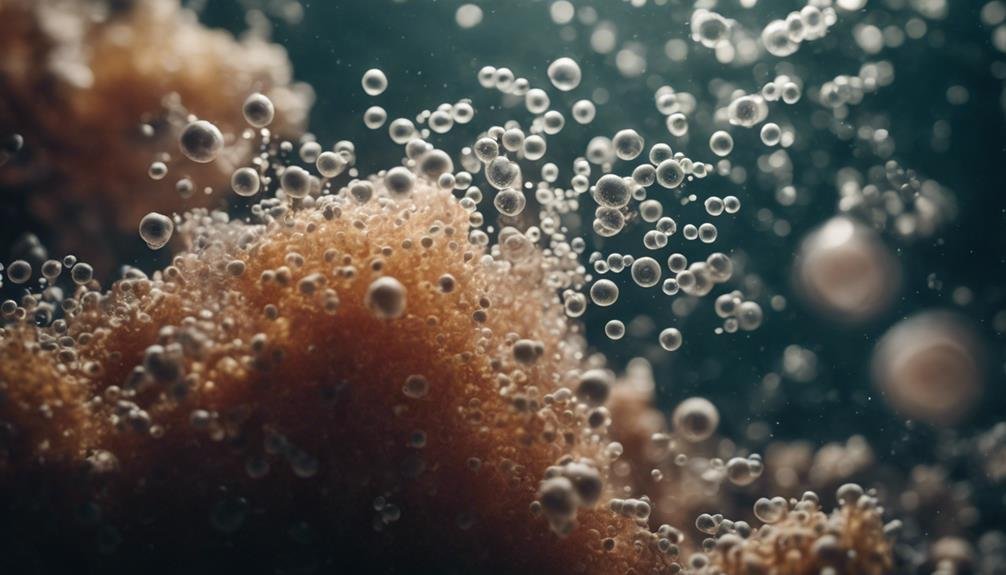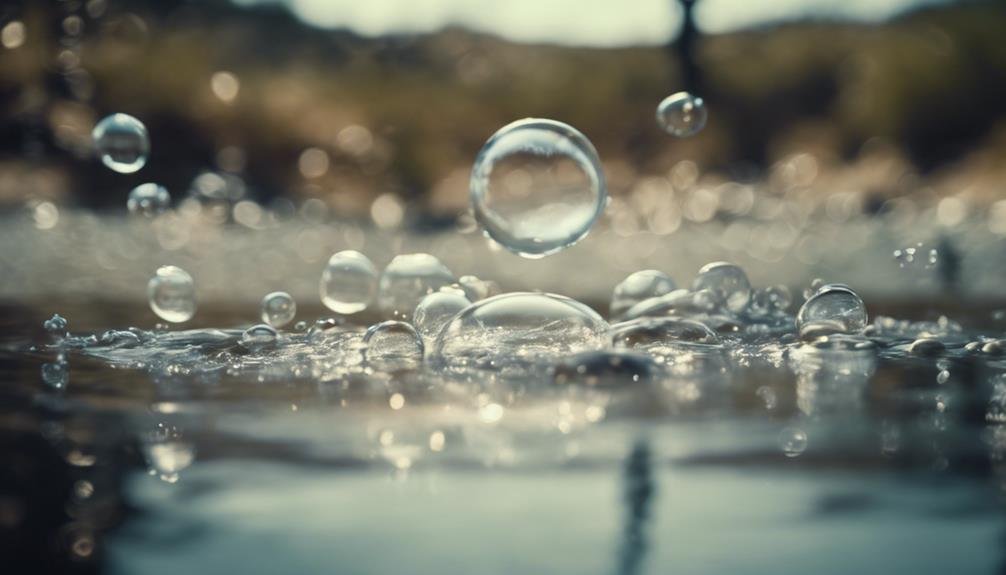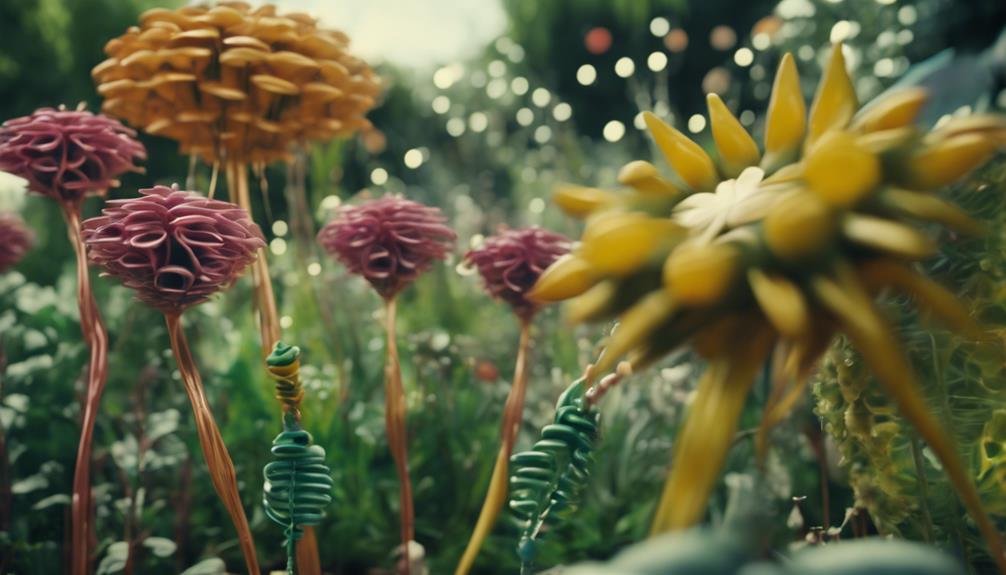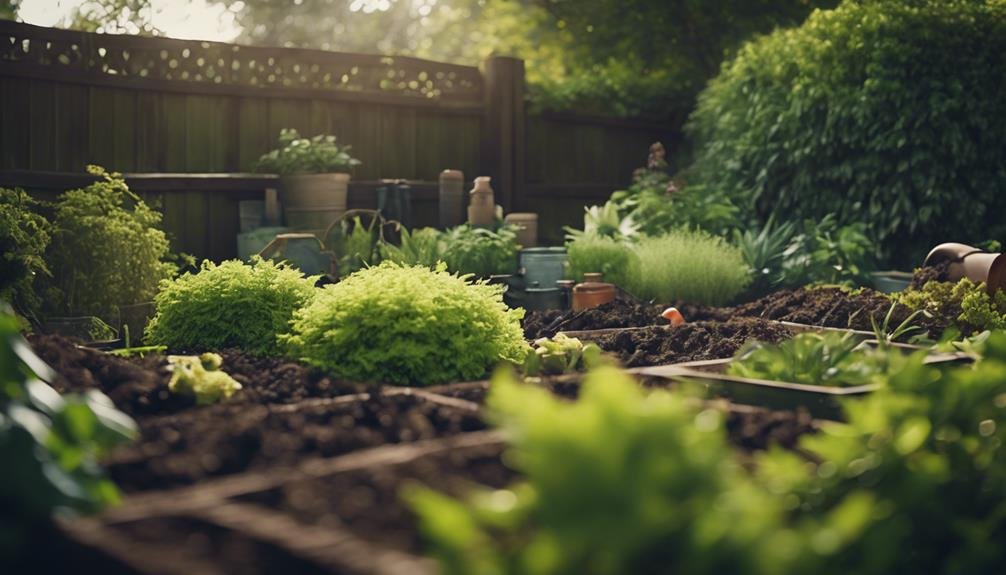We are looking into environmentally friendly ways to add oxygen back into water bodies in a sustainable manner. Renewable energy sources such as solar, wind, and hydropower provide green alternatives for mechanical aeration. Biological processes leverage living organisms, like aquatic plants releasing oxygen through photosynthesis and aerobic bacteria consuming organic waste.
Innovative methods mimic natural processes, such as hydrodynamic vortex aeration that simulates whirlpools and air injection diffusion that introduces air bubbles. Low-energy options include passive ventilation that utilizes airflow. These integrated approaches maintain water quality standards without relying on fossil fuels.
Explore further to discover additional sustainable ways to oxygenate water bodies.
Aerating Water Bodies
Ensuring proper aeration in water bodies is essential for maintaining a healthy aquatic environment. Adequate oxygen levels are crucial for the survival of aquatic organisms and to prevent the accumulation of harmful substances due to stagnation.
There are several effective methods to aerate water bodies. One common approach is using aerators, which introduce air bubbles into the water to help dissolve oxygen. These can vary from basic fountains to more advanced diffused air systems. Mechanical agitation, such as paddle wheels or propeller-driven systems, can also be used to create water movement and increase air exposure on the surface.
Natural aeration techniques, like planting vegetation along the shoreline, can also help. These plants not only offer habitat for wildlife but also assist in oxygen production through photosynthesis. Waterfalls and riffles within the water body can further enhance aeration by increasing turbulence and exposing more of the surface to air.
The choice of aeration method should be based on factors like the size and depth of the water body, as well as specific environmental conditions. It may be necessary to use a combination of techniques for optimal results, ensuring a thriving aquatic ecosystem and upholding water quality standards.
Renewable Energy Aeration
Using renewable energy sources such as solar, wind, and hydropower for aeration presents sustainable options for oxygenating water bodies. These eco-friendly alternatives can help maintain the health of lakes, reservoirs, and ponds without relying on fossil fuels or contributing to greenhouse gas emissions.
Solar power offers clean energy from abundant sunlight, which can be harnessed through photovoltaic panels to power air compressors or mechanical aerators. While solar energy is a dependable option, its effectiveness may be limited by weather conditions.
Wind energy, another renewable source, is cost-effective and can be utilized in areas with suitable wind patterns. Wind turbines can drive aeration pumps, providing a sustainable solution for aerating water bodies.
Hydropower, on the other hand, is a reliable and efficient option that utilizes the kinetic energy of flowing water to operate aeration equipment. This method is particularly suitable for rivers and streams where water flow is consistent.
Although these renewable energy solutions have their limitations, they show great promise as environmentally friendly alternatives to traditional aeration methods powered by non-renewable sources. By embracing renewable energy for aeration, we can support aquatic ecosystems' health while reducing our environmental impact.
Biological Aeration Methods

Utilizing biological processes, biological aeration methods harness living organisms to introduce dissolved oxygen into water bodies. Let's delve into two common biological approaches.
Firstly, aquatic plants such as floating water hyacinths and submerged plants play a vital role in releasing oxygen through photosynthesis. These plants facilitate the transfer of oxygen from the air to the water as they grow, contributing to higher oxygen levels in ponds with abundant plant life.
Another effective method involves the use of aerobic bacteria that feed on organic waste, simultaneously releasing oxygen as a byproduct. By introducing these 'bio-agents' into treatment systems, we can effectively break down pollutants and aerate the water naturally.
Unlike mechanical aerators that rely on electricity or fuel, biological methods leverage nature's own mechanisms for a sustainable solution. However, it's crucial to monitor these systems carefully to ensure optimal conditions for the organisms involved.
When implemented correctly, these eco-friendly techniques can significantly improve water quality without the environmental impact of energy-intensive mechanical aeration systems.
Hydrodynamic Vortex Aeration
Hydrodynamic vortex aeration is a sustainable and eco-friendly method that harnesses the power of whirlpool-like motion to aerate water bodies effectively. By creating a vortex through the injection of water into a cylindrical or conical chamber, this technique generates a low-pressure zone at the center, drawing in air and dispersing it as tiny bubbles throughout the water.
This process doesn't rely on mechanical agitation or additional energy input beyond the initial pumping of water, making it an efficient solution for enhancing oxygen levels in various applications such as wastewater treatment and aquaculture systems.
One of the key advantages of hydrodynamic vortex aeration is its ability to prevent clogging and scaling issues commonly associated with traditional aeration methods. This makes it a reliable and cost-effective option for ensuring adequate oxygen transfer in water treatment processes.
Air Injection Diffusion

Air injection diffusion is a highly effective method that introduces air bubbles into water through specialized diffusers. This technique is crucial for oxygenating stagnant or oxygen-depleted waters, which helps improve aquatic life and prevent foul odors.
By strategically placing diffusers at the bottom of water bodies, compressed air is released in the form of fine bubbles, ultimately increasing dissolved oxygen levels.
One of the key advantages of air injection diffusion is its energy efficiency. Unlike other aeration methods that disrupt the water surface, this technique doesn't require mechanical agitation, making it ideal for ponds, lakes, and wastewater treatment facilities. The diffusers, available in different materials such as ceramics and membranes, are designed for durability and optimal air dispersion.
The installation process for air injection diffusion is straightforward, and maintenance typically involves cleaning or replacing clogged diffusers as needed. The flexibility of adjusting the air flow rate to meet specific oxygen requirements makes this method suitable for a variety of water bodies.
Aeration Through Vegetation
Let's dive into how vegetation contributes to aeration by producing oxygen through photosynthesis. Plants play a crucial role in aerating the root zone by transferring air from the leaves to the roots, which helps create oxygen-rich pockets in the soil.
Furthermore, the movement of plant stems and leaves aids in natural air circulation, boosting the overall aeration process for healthier soil and plant growth.
Plant Oxygen Production
Aquatic plants play a crucial role in naturally aerating water bodies by releasing oxygen through photosynthesis. This process involves absorbing carbon dioxide and producing oxygen as a byproduct, which helps increase the dissolved oxygen levels in the water. This oxygen is essential for the survival and thriving of aquatic organisms such as fish, invertebrates, and beneficial bacteria.
Aquatic plants also provide a surface for oxygen-producing algae and bacteria to cling to, further enhancing the aeration process. The movement of these plants in the water helps circulate and mix the oxygenated water, ensuring a healthy environment for aquatic life.
Different types of aquatic plants contribute to aeration in various ways. Submerged plants like pondweeds and elodea are effective at aerating deeper waters, while floating plants like water lilies and duckweed help aerate the surface layers. A diverse mix of aquatic vegetation is recommended to ensure comprehensive aeration throughout the water column.
Root Zone Aeration
To boost oxygen levels in water bodies, we can employ root zone aeration alongside the oxygen production from aquatic plants. This method involves strategically situating plant roots in the water to create pathways for oxygen diffusion. The roots play a crucial role by allowing atmospheric oxygen to enter the water, releasing oxygen as a byproduct of their metabolism, and establishing air-filled spaces within the root zone to enhance aeration.
By implementing root zone aeration, we can effectively improve the oxygen content in water bodies, promoting a healthier aquatic ecosystem. This eco-friendly approach not only increases oxygen levels but also supports the growth and vitality of aquatic life. Additionally, it helps mitigate issues like algae blooms and fish kills by maintaining a balanced oxygen supply in the water.
One recommended product for root zone aeration is a diffuser system that can be easily installed near aquatic plants to enhance oxygen transfer. These systems are designed to efficiently oxygenate the water column by creating bubbles that travel through the root zone, promoting aeration and improving water quality.
Natural Air Circulation
By strategically placing vegetation, we can improve natural air circulation in water bodies. Aquatic plants with hollow stems play a key role in this process by allowing air exchange between the atmosphere and underwater sediments. As these plants undergo photosynthesis, they release oxygen into the water while absorbing carbon dioxide for respiration through their stems. This continuous cycle enhances oxygen levels and overall water quality.
Moreover, promoting the growth of emergent vegetation along shorelines helps create pathways for atmospheric air to reach the sediment, preventing oxygen-depleting anoxic conditions. The roots of these plants also reduce excessive algae growth by providing shade, which in turn prevents oxygen depletion caused by algal respiration and decomposition.
Biomimicry-Inspired Solutions

Let's delve into how we can draw inspiration from nature for eco-friendly aeration solutions.
Biomimicry, which involves mimicking natural systems or processes, presents innovative ventilation techniques inspired by the intricate patterns found in living organisms.
These nature-inspired methods replicate structures honed through evolution, offering sustainable oxygenation while reducing environmental harm.
Biomimetic Aeration Designs
Nature provides innovative aeration solutions that we can replicate through biomimetic designs. By studying natural systems, we've uncovered sophisticated structures and mechanisms for effective gas exchange. One striking instance is the respiratory system of insects, which consists of a network of small tubes known as tracheae that deliver oxygen directly to cells. We can imitate this concept in our aeration systems by creating small channels to increase surface area and optimize oxygen transfer.
Another inspiring example comes from the gills of aquatic creatures, which facilitate gas exchange with the water around them. Biomimetic gill-like structures could significantly improve aeration in wastewater treatment processes. Moreover, we can take cues from the intricate vascular systems of plants, which transport gases and nutrients throughout the plant. By integrating these principles, we can design aeration systems with branching networks, microporous surfaces, and optimized flow patterns to enhance efficiency.
In practical terms, biomimetic aeration designs can revolutionize various industries, such as wastewater treatment plants and aquaculture facilities. For instance, implementing miniaturized channels inspired by insect tracheae can boost oxygen transfer rates in aeration tanks, leading to better water quality. Similarly, incorporating gill-like structures in aeration equipment can improve the oxygenation process in fish farms, promoting healthier aquatic environments.
Nature-Inspired Oxygenation Techniques
Taking cues from nature's brilliant designs, we're developing aeration techniques inspired by biological mechanisms to enhance gas exchange efficiency. One approach is inspired by the intricate structure of plant leaves, which feature tiny pores called stomata for efficient gas exchange. By replicating this design in aeration systems, we can create surfaces with numerous micro-openings that facilitate effective oxygen transfer while minimizing energy consumption.
Another nature-inspired solution involves mimicking the respiratory systems of aquatic organisms like fish and insects. These creatures have evolved specialized structures, such as gills or tracheal systems, to maximize surface area for gas exchange. By applying similar principles, we can design aeration devices with increased surface area and improved oxygenation capabilities.
Furthermore, we're exploring biomimetic materials that replicate the properties of biological membranes, enabling selective permeability for efficient gas transfer. These materials can be integrated into aeration systems, forming semipermeable barriers that enhance oxygenation while blocking unwanted contaminants from entering the water.
Through ongoing research and innovation, our goal is to develop environmentally friendly aeration methods that not only enhance oxygenation efficiency but also reduce energy consumption and environmental impact, thus contributing to a more sustainable future.
Sustainable Ventilation Biomimicry
Drawing inspiration from nature, we're developing eco-friendly ventilation systems that imitate biological processes to provide energy-efficient air circulation solutions. By observing how living organisms exchange gases, we can design innovative systems that enhance airflow efficiency while reducing environmental harm.
Our research focuses on three main areas:
- Drawing from the design of leaves for natural ventilation solutions.
- Mimicking the respiratory system to improve active airflow control.
- Creating structures similar to lungs for optimal gas exchange.
For instance, we're studying the porous makeup of leaves to develop building materials that promote natural air flow, reducing the reliance on energy-intensive cooling systems.
Similarly, by examining how lungs function in gas exchange, we aim to produce advanced filters and membranes that can purify air effectively while conserving resources.
Through sustainable ventilation biomimicry, our goal is to develop environmentally friendly systems that meet ventilation needs while minimizing carbon emissions and ecological impact.
Low-Energy Aeration Techniques
In our pursuit of sustainable aeration methods, we're exploring low-energy techniques to reduce environmental impact. One effective approach is natural ventilation, which harnesses passive airflow from wind and thermal buoyancy. By strategically designing buildings with openings, chimneys, and wind catchers, we can promote air circulation without relying on energy-intensive mechanical systems.
Another efficient method is the use of earth-air heat exchangers, which involve buried pipes to pre-cool or pre-heat incoming air by tapping into the stable underground temperatures. This practice helps decrease the workload on traditional HVAC systems, resulting in significant energy savings.
Additionally, displacement ventilation is a highly effective strategy that introduces fresh air at floor level while allowing warm, stale air to rise and exit through ceiling vents.
Drawing inspiration from nature's ingenious designs, such as termite mounds or prairie dog burrows, low-energy aeration techniques mimic passive ventilation principles to maximize efficiency. By adopting these sustainable strategies, we can greatly reduce energy consumption while ensuring comfortable indoor environments for occupants.
Integrated Aeration Approaches

To enhance efficiency, we blend various aeration methods to create customized approaches based on specific site conditions. By combining eco-friendly techniques, we can improve aeration effectiveness while minimizing harm to the environment and reducing energy usage.
Integrated aeration strategies typically involve three main components:
- Natural aeration techniques such as surface aerators and cascade aerators.
- Low-energy artificial aeration methods like fine bubble diffusers and air-lift pumps.
- Operational tactics like intermittent aeration and adjustable airflow rates.
For example, in a wastewater treatment facility, we may use surface aerators to kickstart oxygenation, followed by fine bubble diffusers for optimal oxygen transfer during biological treatment processes.
Incorporating intermittent aeration cycles and adjusting airflow rates can help lower energy consumption while ensuring sufficient dissolved oxygen levels are maintained.
Conclusion
Choosing eco-friendly aeration methods breathes new life into our water bodies, nurturing their health and vitality. These solutions act as gentle ripples, spreading sustainability and harmony between humans and nature. By adopting these practices, we become agents of positive change, infusing every drop of water with a commitment to long-term well-being.
Eco-friendly aeration methods play a crucial role in maintaining the balance of aquatic ecosystems. They help increase oxygen levels in water, promoting the growth of beneficial bacteria and reducing the presence of harmful pollutants. One such innovative solution is using solar-powered aerators, which harness the sun's energy to oxygenate water bodies without any carbon footprint. These aerators aren't only efficient but also environmentally friendly, making them a sustainable choice for preserving our precious water resources.
By incorporating eco-friendly aeration methods, we can ensure that our water bodies remain vibrant and healthy for future generations. Let's take the lead in embracing these sustainable practices and pave the way for a greener, more resilient planet.

